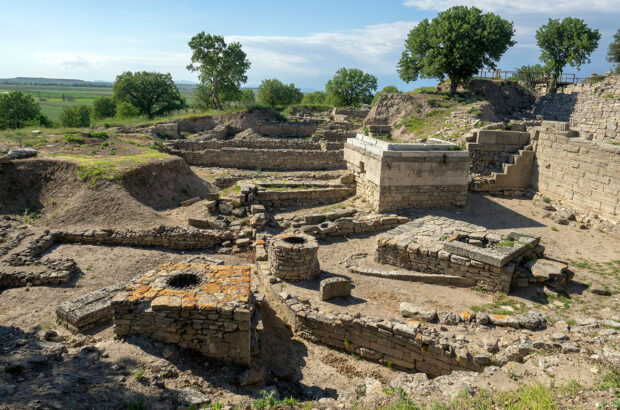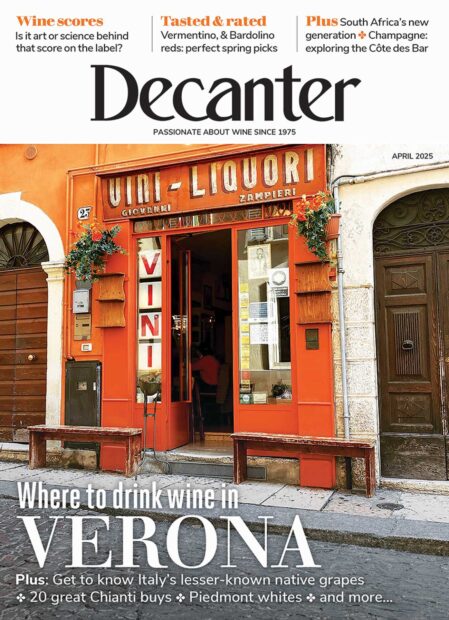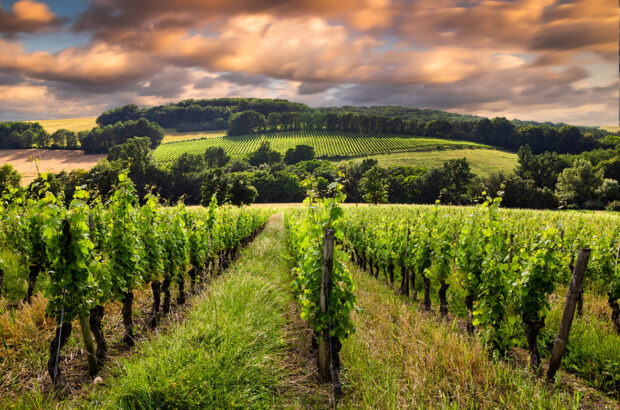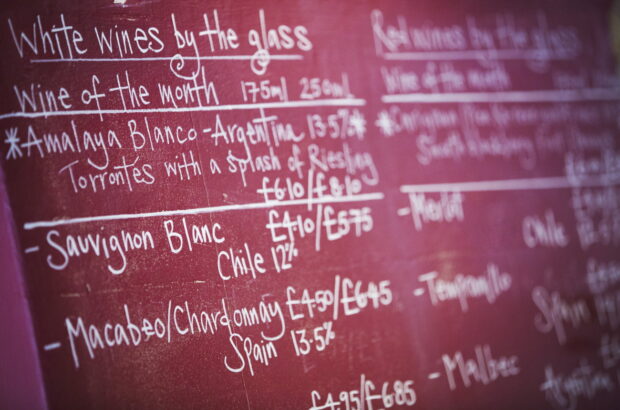Bordeaux has a history of extraordinary women running vineyards.
In Sauternes & Barsac
Françoise-Joséphine d’Yquem was imprisoned twice during the French revolution but managed to save both her neck and Château d’Yquem, 1er Grand Cru Classé Supérieur Sauternes. She then dedicated herself to her property, and introduced the practice of ‘tries successives’ or multiple passes through the vineyard during harvest to collect botrytised grapes at maximum maturity, transforming the quality of wines from the whole appellation.
Her legacy lives on. Sandrine Garbay followed her footsteps at Château d’Yquem but is now at neighbouring Château Guiraud, where the new owner Matthieu Gufflet has entrusted her with both winemaking and overseeing the whole estate, including launching a new wine tourism venture with a 26-room hotel planned for 2025.
At Château Sigalas Rabaud, 1er Grand Cru Classé Sauternes, sixth-generation Laure de Lambert Compeyrot has also embraced wine tourism with five exquisite guest rooms. She has extended her range adding a 100% dry white Sémillon and a sulphur free, semi-sweet Bordeaux. Her latest is the first cuvée of a sparkling Semillon, La Marquise in honour of her grandmother, who ran the property in the 1950s.
Franco-American Aline Baly is the third-generation to join the family business at nearby Château Coutet in Barsac bringing a different kind of dynamism to the industry. Having studied and worked across the US, Europe and Asia, she now co-owns and manages the estate with her uncle as well as being the director of marketing at Baron Philippe de Rothschild.

Aline Baly, Château Coutet
In the Médoc
My favourite historical heroine is Château Cantemerle’s Caroline de Lalande who, at 72 years old, challenged courtiers and négociants to add Cantemerle to the 1855 classification – she won. Today, Laure Canu runs both Château Cantemerle, 5ème Grand Cru Classé Haut-Médoc, and Grand Corbin, Grand Cru Classé in St-Emilion. Currently renovating, she is tripling the size of the cellars, creating a visitor centre and adapting the château for guests.
Perhaps the best known Bordeaux property owned and run by a woman is Bordeaux first growth Château Margaux, which is run by Corinne Mentzelopoulos, now joined by her daughter Alexandra. She’s not the first woman in charge here. In the 17th century Château Margaux was part of the business empire of Olive de Lestonnac, known as ‘La Dame de Margaux’. She was the richest woman in Bordeaux when she died at the château in 1652 at the grand age of 80.
Another Médoc mother and daughter team is Lillian and Melanie Barton Sartorius. Châteaux Langoa, and Leoville Barton, have been in the family since the 1820s. Lilian runs the classified growths, that reopen to visitors this spring after extensive renovation. In 2011, with her husband, Michel Sartorius, they bought Château Mauvesin Barton in Moulis. Their daughter Melanie, the first qualified oenologist in the family, joined them in 2013 – the eighth generation Barton to put their mark on the Médoc.

Lilian Barton Sartorius, Château Léoville Barton
In 1992, two Lurton sisters took on respective family estates; Berenice became an early advocate for biodynamics at Château Climens in Barsac making spectacular wines in this challenging micro-climate while Marie-Laure took over the family vineyards at Château de Villegeorge in Haut Médoc and Château La Tour de Besan in Margaux. La Tour Besan typifies Bordeaux old meets new. The château takes it’s name from a 12th century lookout tower but Marie-Laure makes the wine in a 1930s telecommunications centre converted into an ultra-modern cellar.
Their sister-in-law, Claire Villars Lurton, is also a passionate advocate for organic and biodynamic viticulture and agro forestry at Châteaux Haut-Bages Libéral (5ème Grand Cru Classé Pauillac), Ferrière (3ème Grand Cru Classé Margaux) and La Gurgue (Margaux). Her career in wine was not planned, she stepped into the role in her twenties upon the sudden death of her parents. She started working alongside her maternal grandfather Jacques Merlaut and has never looked back.

Claire Villars-Lurton, owner of Château Haut-Bages Libéral, Ferrière and La Gurgue
Nathalie Perrod, also took over Châteaux Labegorce and Marquis d’Alesme in her twenties upon the death of her father. As the vines of Marquis d’Alesme came without a château, Nathalie built one. Functional and beautiful, it’s inspired by her dual Chinese and French heritage. A zen cellar for director-winemaker Marjolaine Maurice de Coninck. There’s a relaxed restaurant in a herb garden where guests can sip on a coffee as well as a glass of wine. A young mother, she welcomes children with a Le Petit Marquis treasure hunt.
Saskia de Rothschild succeeded her father as chairman of Domaines Barons de Rothschild (Lafite) in 2018 and replaced Jean-Guillaume Prats as Lafite’s first female CEO and general director in 2021. In her previous career she was an international journalist, but she’s not new to the job, having participated in harvests and blendings in France and at the group’s international estates over the years. In 2021, she introduced a new, reusable bottle for Château Rieussec in Sauternes – a nod to sustainability which underlies her philosophy for the estate’s evolution to organic viticulture. She also channelled her journalistic talents into a magnificent Almanac (1868-2018) which documents 150 vintages of Bordeaux first growth Château Lafite through recorded climatic details and gorgeous photos, thanks to her father Eric’s foresight in inviting photographers to harvests over the years.

Saskia de Rothschild, CEO of Domaines Baron de Rothschild Lafite.
Daisy Sichel shares her family home Château Angludet in Margaux, driving guests around the vines in an electric golf cart. Her passion is biodiversity with just 32 of the 81 hectares under vine – the rest of the property is meadows and woods with 200 fruit trees planted among the vines. Treating her guests after the visit, Sichel serves a signature chocolate fondant, created by Patisserie chef Clarisse Argout, specifically to pair with a glass of Château Angludet 2011.
Veronique Dausse also believes in food to showcase her wines at Château Phélan Ségur in St-Estèphe. She started a tradition of gastronomy under the ownership of the Gardinier family, whose background was in hospitality. A tradition that continues under the new ownership of Philippe Van de Vyvere with full time chef Jean-Luc Beaufils. Part of this philosophy is their sponsorship of the Concours des Sommeliers. Hopes were high this year for French candidate Pascaline Lepeltier, who came fourth, the silver went to Nina Jensen (as we’re celebrating women).
Sara Lecompte Cuvelier (pictured, main) was in human resources before coming to the family properties of Château Léoville Poyferré (2ème Grand Cru Classé St-Julien), Moulin Riche (St-Julien) and Château Le Crock (St-Estèphe) in 2018. Studying a master’s degree in wine estate management to get up to speed, she works alongside oenologist Isabelle Davin at Poyferré. Like many, rising to the climatic and environmental challenges wine faces are her main concern.
In Pessac-Léognan
Veronique Sanders is the fourth generation of her family at Château Haut-Bailly, Grand Cru Classé de Graves, even though they no longer own it. When her grandfather sold in 1998, new owner, Robert Wilmers, asked her to stay. Veronique continues to guide the estate with the same level of passion. She created the private table concept in its beautiful dining room and transformed neighbouring Château Le Pape into an exclusive guest house. Last year she inaugurated the spectacular carbon neutral cellar at Haut-Bailly – a positive both for the natural and the working environment. The effect is one of elegance and discretion, just like the wine and Veronique.

Veronique Sanders, Château Haut-Bailly
Creating accessibility and opening up to wine tourism is an ambition both Veronique and Florence Cathiard seem to share. A true pioneer, in the 1990s Florence redesigned Château Smith Haut Lafitte, Grand Cru Classé de Graves, so wine production and wine tourism could work side by side. Her daughter, Alice Tourbier, followed in her footsteps creating the hotel and wine spa complex Sources de Caudalie in the vineyard.
In Entre-deux-Mers
Sisters Marie and Sylvie Courcelle co-own Château Thieuley in the Entre-deux-Mers. Alongside their Bordeaux range, they produce a 100% Chardonnay and a 100% Shiraz bottled as a Vin de France, and they also have a lot of fun with their ‘deux soeurs’ labels.
Estelle Roumage, the third generation winemaker at Château Lestrille. showcases her passion for the environment through her labels, her bag in box wines and her latest project, a Miyawaki micro forest. Once matured it will become part of a vineyard nature trail to coincide with her organic certification.
Veronique Barthe is also the third generation and first woman at the helm of 80ha Château la Freynelle, a vineyard planted in the year of the French revolution. She also co-owns and runs the organic St-Emilion Grand Cru winery Château d’Arcole.
At Château Du Payre the property has been passed down from mother to daughter for five generations and is now run by Valérie Labrousse-Marcuzzi. They will be certified organic this year.
St-Emilion
Being part of a wine family isn’t always a shoe in. The Duffau-Lagarrosse family has owned Château Beauséjour, St-Emilion 1er Grand Cru Classé, since 1847. By 2020, thanks to French inheritance laws, the property had 30 family shareholders, including ninth generation Joséphine, who had worked her way around the wine world before returning home. When the family wanted to sell in 2021, Joséphine decided she didn’t, but she needed financial backing to buy out the remaining shareholders. The Courtin-Clarins family came to the rescue and, after a bidding war with neighbours Château Angélus and Clos Fourtet, and the intervention of the French government, they purchased the property. The estate is now owned and run by 31-year-old Joséphine and Prisca Courtin-Clarins.

Joséphine Duffau-Lagarrosse, Château Beauséjour
Stéphanie de Boüard-Rivoal, co-owner and CEO of Château Angélus in St-Emilion joined the family firm after a career in banking. The eighth generation at the head of the estate, she created the embossed bottle to celebrate the 2012 vintage when they became Premier Grand Cru Classé A. She reorganised production, designing new cellars for the Carillon d’Angélus and N°3 d’Angélus wines. In 2013, she diversified into hospitality, buying Le Logis de la Cadène restaurant, La Maison de la Cadène and L’Auberge de la Commanderie in St-Emilion. Then in 2019, she spread her wings to Bordeaux, buying Le Gabriel on the Bordeaux water front working with chef Alexandre Baumard to gain a Michelin star. In 2021, the tiny-production Hommage à Elisabeth Bouchet (made from old-vine Cabernet Franc and only in the best vintages) was introduced and this year sees the release of a new 100% Merlot cuvée, Clos du Milieu, made entirely from Angélus vines.

Stéphanie de Boüard Rivoal, Château Angélus
Château Ausone is another iconic right bank name whose wines are now in the capable hands of a young women. Pauline Vauthier made wine in South Africa while learning oenology before coming back home in 2006 to work alongside her father. The eleventh generation, she now signs the wines of all the family estates.
Pomerol
Catherine Conseillan purchased land in Pomerol back in the 18th century, creating La Conseillante, she renovated and extended the estate to its current 12 hectares. Five generations later, under ownership of the Nicolas family, Marielle Cazaux is at the helm, making the wine and managing the team with innovation at the fore – she uses no sulphites and is experimenting in the cellars with integral fermentation and amphoras.

Marielle Cazaux, Château La Conseillante
Not all women inherit or follow their family into the businesses and not all are from Bordeaux.
British Sally Evans left a corporate career and started a new life as a winemaker in her fifties. She created Château George 7 from a few hectares and a tractor barn in the hills of Fronsac. Starting from scratch, with no preconceived ideas meant she could be both innovative and sustainable. She now wins accolades for both her red and white wines and her wine bar with outside terrace overlooking the vineyard.
Since 2006, Youmna Asseilly’s legendry Lebanese hospitality is the driving force behind Château Biac in Cadillac – a property with one of the best views in Bordeaux across the Garonne river. Her daughter Yasmina joined her in 2013 and together they work with oenologist Christine Sourdes who created their dry white wine and crafts their sweet Cadillac.
Charlotte Krajewski’s passion for wine started at Château de Sours in the Entre-deux-Mers, famous for its rosé. When the family sold the property in 2016 to Alibaba cofounder Jack Ma, they kept their Clos Cantenac Grand Cru estate in St-Emilion and purchased some vines in Pomerol. Charlotte was away studying Oenology at Plumpton College and then worked her way through the vineyards of the New and Old World before returning to Bordeaux in 2017. She took over winemaking at both properties just in time for the first vintage of Château Séraphine in Pomerol. As befits the family tradition, she also makes the delicious L’Exuberance rosé.
Above are just some of the many dynamic women in Bordeaux wine – there are many more: Caroline Teycheney at Vignobles Jade, Martine Caseneuve who created Château Paloumey replanting an abandoned vineyard, Armelle Cruze who runs Château le Taillan on behalf of her five sisters, Pauline Bich Chandon-Moët who has made Château de Ferrand into a showcase for both wine and Art, Brigitte Rullier-Loussert at Château Dalem in Fronsac, Gwendeline Lucas, director of Vignobles Fayat, Pascale Peyronie owner/winemaker of Château Fonbadet in Pauillac and Anabelle Cruse Bardinet at Château Corbin. I could go on.
It’s a community as diverse and as dynamic as the initiatives they are undertaking. The spirit of their historical heroines lives on.







